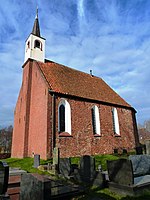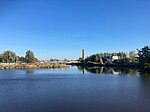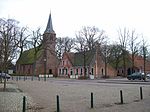Midwolde

Midwolde (Dutch pronunciation: [mɪdˈʋɔl.də]; Gronings: Midwolle) is a village in the municipality of Westerkwartier in the province of Groningen in the Netherlands. As of 2021, it had a population of 185. It is located just to the northeast of Leek. Midwolde is known for its church, the oldest part of which (the nave) dates from the 12th century. The church is located north of the Nienoord estate and therefore had close relations with it in the past. In the church is the tomb of Carel Hieronymus von Inn- und Kniphausen (1631-1664), a major work by Rombout Verhulst and Bartholomeus Eggers. A stained glass window recalls the accident in 1907 in which the Van Panhuys family drowned in the Hoendiep. The name means: forest (wold) in the middle (mid-). The name is very similar to that of Midwolda, which is located in the east of the province of Groningen in the municipality of Oldambt and which is much larger.
Excerpt from the Wikipedia article Midwolde (License: CC BY-SA 3.0, Authors, Images).Midwolde
Hoofdstraat, Westerkwartier
Geographical coordinates (GPS) Address Nearby Places Show on map
Geographical coordinates (GPS)
| Latitude | Longitude |
|---|---|
| N 53.183333333333 ° | E 6.4 ° |
Address
Hoofdstraat 156a
9355 TE Westerkwartier
Groningen, Netherlands
Open on Google Maps











